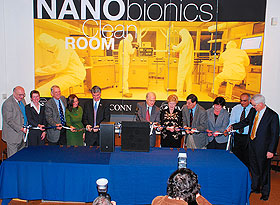  |
| HOME | THIS ISSUE | CALENDAR | GRANTS | BACK ISSUES | < BACK | NEXT > |
Nanotechnology 'clean room' opens at IMS by Colin Poitras - October 27, 2008 |
||||
| The University dramatically expanded its nanotechnology research capabilities this month, with the opening of a 1,000-square-foot ‘clean room’ that will allow scientists to fabricate cutting-edge devices for use in defense, industry, and medicine. Gov. M. Jodi Rell, President Michael J. Hogan, and a host of other elected officials and University representatives acknowledged the opening with a ribbon-cutting ceremony Oct. 20 at the Institute of Materials Science (IMS) in the Edward V. Gant Science Complex. The Nanobionics Fabrication Facility – as the dust-free ‘clean room’ is formally known – supplements state-of-the-art research technology worth more than $20 million that is currently available at the IMS, including high-power electron microscopes, atomic force microscopes, and advanced spectrometers. Hogan called the $2 million facility a “significant milestone” in UConn’s continuing program to build new interdisciplinary scientific initiatives. “This new nanobionics clean room is one part of UConn’s comprehensive nanotechnology infrastructure that we think is second to none in Connecticut,” Hogan said. “The possibilities of nanotechnology are innumerable, with the potential to revolutionize every facet of applied science and modern technology – from high-tech manufacturing to military devices to fuel cells to new methods of health care.” The University has invested more than $7 million of its own funds in support of nanotechnology research facilities and faculty as part of its revised academic plan. Nearly 80 faculty members from UConn’s College of Liberal Arts and Sciences and the Schools of Engineering, Medicine, Dental Medicine, Pharmacy, and Agriculture are now actively engaged in nanotechnology research. Together they have received more than $25 million in research grants over the past three years. Nanotechnology is the science of manipulating biological, chemical, and other material particles on an ultra-small scale – smaller than one-hundred-thousandth the width of a human hair. The clean room offers both wet and dry processing capabilities. Researchers working inside the room must wear white Gore-Tex suits and special shoe covers and gloves to protect the sterile environment, which allows for no more than 1,000 microdust particles per cubic meter of air. The clean room is expected to advance UConn research into such things as a nanosized implantable glucose sensor for diabetics. It will also help Robert Birge, holder of the Harold S. Schwenk Sr. Distinguished Chair in Chemistry, in his quest to develop an artificial retina.
Nejat Olgac, the head of UConn’s Advanced Laboratory for Automation, will use the room to help with the ongoing development of a nanoscopic device that can transfer genetic material into cells with greater accuracy and effectiveness – a potential boon for nanomedicine. In addition, nanotechnology is expected to have a major impact on next-generation energy concepts, such as state-of-the-art solar and fuel cells. The nanobionics fabrication facility was made possible in part through a U.S. Army Center grant, in conjunction with pooled resources and equipment from the University’s nanobionics-associated faculty and IMS. In addition, UConn 2000 funding supported the necessary infrastructure improvements to make the clean room, said Professor Fotios Papadimitrakopoulos, director of the Nanobionics Fabrication Facility and associate director of IMS. “Nanobionics lies at the intersection of nano- and bio-technology, where artificial nanomaterials and devices are complemented with biological function,” Papadimitrakopoulos said. “This facility intends to enable researchers across the state to realize advanced devices, along with bridging different disciplines to cross-fertilize new concepts.” UConn is the only place in the state that high-technology businesses can come to access equipment that can characterize, synthesize, manipulate, or assemble matter on the nanoscale level. Each year, more than 40 Connecticut companies use UConn’s expertise in nanotechnology and materials science for their research and development efforts. “The basic scientists in UConn’s College of Liberal Arts and Sciences, such as Fotios Papadimitrakopoulos in our Department of Chemistry, are providing knowledge about the nature of matter that is at the foundation of work in nanotechnology,” said Jeremy Teitelbaum, dean of the College. |
| ADVANCE HOME UCONN HOME |

